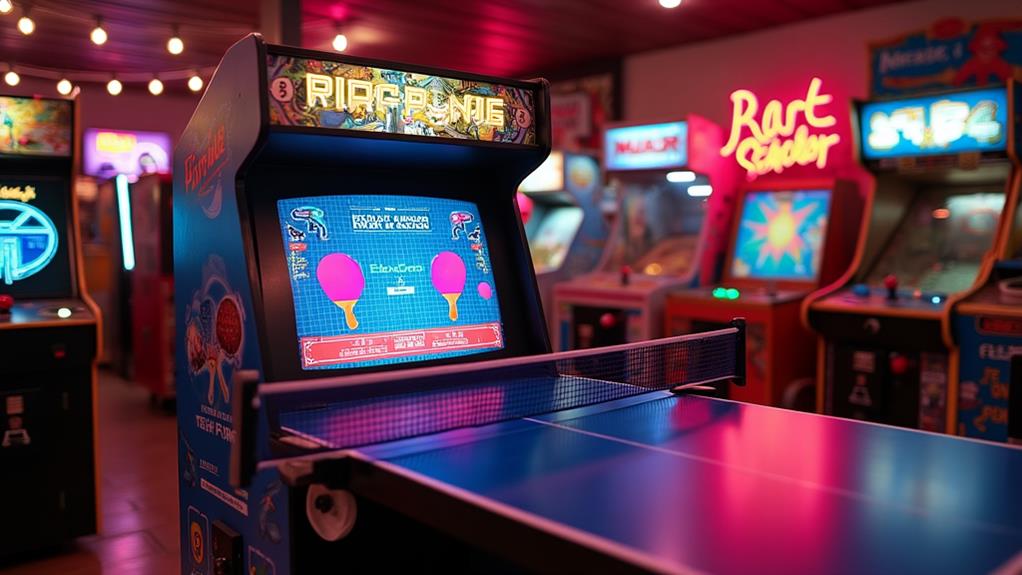What Is the Ping Pong Arcade Game Called?

The ping pong arcade game you're thinking of is called "Pong." Created by Atari and released on November 29, 1972, Pong stands as one of the earliest and most influential arcade games ever made. It mimics table tennis, where you control paddles to hit a ball back and forth, aiming to score points. Initially, it tackled production challenges but quickly skyrocketed in popularity, selling thousands of units and making substantial daily earnings. Though it faced legal issues with Magnavox, Pong's legacy endures, having been inducted into the World Video Game Hall of Fame. There's much more to uncover about its fascinating expedition and impact.
History of Pong
Although Pong initially began as a simple training exercise, it quickly evolved into a landmark in arcade gaming history. Released by Atari on November 29, 1972, Pong was one of the earliest arcade games, created by Allan Alcorn. Inspired by an electronic ping-pong game on the Magnavox Odyssey, Pong faced a patent infringement lawsuit from Magnavox. Despite this challenge, the game achieved remarkable commercial success.
Initially, production was slow, with only ten machines assembled daily. However, by 1974, Atari had sold over 8,000 units, leading to significant increases in orders and income. This success was further amplified when a home version of Pong was released in collaboration with Sears during the 1975 Christmas season. This home version sold approximately 150,000 units, demonstrating the game's widespread appeal.
Pong's impact on the video game industry is undeniable. Its cultural significance has been recognized with its induction into The Strong National Museum of Play's World Video Game Hall of Fame in 2015. Moreover, it holds a place in notable collections, including the Smithsonian Institution, solidifying its legacy in the history of video games.
Gameplay Mechanics
Pong's gameplay mechanics are simple yet engaging, making it a timeless classic. In this Pong Arcade game, you and an opponent control paddles to hit a ball back and forth, simulating a game of table tennis. Each paddle is divided into eight segments, allowing you to vary the angle at which the ball is returned, adding a layer of strategy to your game.
To score points, you need to confirm your opponent fails to return the ball. The initial player to reach eleven points wins the game, keeping the competition fierce and exciting. As rallies continue, the ball's speed increases, challenging your reflexes and precision. However, if a player misses the ball, it resets to a slower speed, giving both players a chance to regain control.
Sound effects in Pong aren't just for show—they're generated using a sync generator, adding to the game's engaging experience with distinctive tones that signal each bounce and point scored. These elements make Pong more than just a game; it's an captivating experience where players control their paddles with precision, aiming to outmaneuver their opponent and dominate the digital table tennis arena.
Development and Release
The inception of Pong marked a groundbreaking moment in the history of arcade gaming. Developed by Atari and released on November 29, 1972, Pong was one of the earliest arcade video games. Allan Alcorn created it as a training exercise, drawing inspiration from an electronic ping-pong game on the Magnavox Odyssey. The initial prototype was built using a $75 Hitachi black-and-white TV.
You'd be amazed at the challenges Atari faced during the production phase. They managed to assemble an average of only ten machines daily. Despite these hurdles, the dedication paid off. By 1974, Atari had sold over 8,000 units of Pong, setting a significant milestone in the arcade gaming industry.
Let's break down the key stages in Pong's development and release:
- Initial Development: Allan Alcorn developed Pong as a training exercise, using limited resources like a $75 TV.
- Production Challenges: Atari struggled to produce enough units, initially assembling just ten machines per day.
- Global Market Expansion: By 1973, Pong began shipping internationally, establishing its presence in the global market.
These efforts led to Pong becoming a cornerstone in the world of electronic gaming, forever changing the landscape of arcade video games.
Market Impact
When Pong hit the market, it didn't just make waves; it created a seismic shift in the arcade game industry. As the initial commercially successful video game, Pong not only dominated arcades but also inspired a slew of similar games from competitors. Its arcade version generated estimated daily earnings of $35-$40 per unit, making it four times more successful than its closest rivals. This success was a clear indicator of the game's impact on the video game market.
Atari, the company behind Pong, capitalized on this momentum by releasing a home version. Limited releases through Sears sold around 150,000 units, marking a triumphant entry into the home gaming market. This move was crucial in the growth of the video game industry, laying the groundwork for future developments in both arcade and home console gaming.
Pong's cultural significance extends beyond its financial success. Recognized by institutions like the Smithsonian, it has cemented its place not only in gaming history but also in broader entertainment culture. Pong's influence is undeniable, shaping the trajectory of video games and establishing a legacy that continues to influence the industry today.
Legal Battles
Atari's success with Pong wasn't without its challenges. In April 1974, Magnavox filed a lawsuit against Atari, claiming that Pong infringed on their patents tied to the Odyssey console, designed by Ralph H. Baer. The legal battles highlighted the complexities of patent law in the burgeoning video game industry.
Here are three critical points from this legal tussle:
- Settlement: The lawsuit was settled in June 1976 when Atari agreed to pay $1.5 million. This settlement not only made Atari a licensed manufacturer of games using similar technology but also established a precedent for future video game development.
- Magnavox's Continued Legal Actions: Even after settling with Atari, Magnavox pursued other companies producing similar games. They aimed to safeguard their intellectual property in a rapidly evolving market filled with competitors.
- Commercialization Amidst Legal Scrutiny: Despite the legal issues, Atari struck a significant deal with Sears to produce Home Pong, agreeing to manufacture 150,000 units. This move underscored the commercialization potential of video gaming technology despite ongoing legal challenges.
These legal battles didn't just shape Atari's future but also influenced the entire video game industry, setting standards for patent disputes and licensing agreements.
Cultural Significance
Cultural resonance is what Pong achieved following its release in 1972, becoming the initial commercially successful video game and laying the foundation for arcade culture in the 1970s and 1980s. Pong's simple mechanics and multiplayer format made it a "social lubricant," accessible and enjoyable for everyone. This ease of play attracted a wide audience, making Pong culturally significant and a staple in arcades.
Pong's influence extended beyond just gameplay. It has been referenced in TV shows like That 70s Show and King of the Hill, cementing its place in popular culture. Its significance was further recognized when the Smithsonian Institution included it in their collection, highlighting its impact on society. Moreover, Pong was inducted into the World Video Game Hall of Fame in 2015, underscoring its lasting legacy.
The game's success led to numerous clones and adaptations, showcasing its influence on the video game industry. These clones contributed to the rise of home gaming consoles, bringing the arcade experience into living rooms. Pong's role in shaping both arcade culture and the broader gaming landscape can't be overstated.



